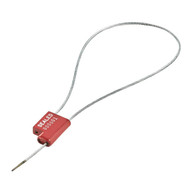Reasons for Using Cable Seals in Fuel and Oil Tank Terminals and Transportation
Posted by Steve Diebold
Oil and gas companies that value security are increasingly switching to more rigid sealing procedures to safeguard against unauthorized access and the compromise of operational controls. Recently, most petrochemical companies and businesses worldwide have chosen cable seals as their preferred locking mechanism option because of its strong locking solution.
These seals are used to prevent unauthorized access or unintentional opening or closure of vital valves, controls, tanks, and other equipment at processing, storage, and loading terminals. Moreover, the sealing of bulk containers and tankers in transport provides tamper evidence and discourages theft. With such diverse usage, seals are really in demand for fuel and oil tank terminals and transportation. Fortunately, it’s such a good thing that American Casting & Manufacturing offers a broad variety of cable seals in its product catalog for you to venture on.
For many years, it was thought that a basic indicative seal with reliable tamper indication was adequate for these sealing purposes. Band seals made of metal or plastic were often used. However, as both complexity and risk rise, so too do safety and security standards and procedures. Stronger security seals that create a physical barrier are progressively replacing the less reliable indicative seals.
Most of these safety aspects are recognized by oil industry risk and safety management as a possible threat to the security of corporate assets and personnel, as well as the general public. As a result, oil safety management made use of a more proactive measure to avoid accidents and avoid fraudulent behaviors through the pull-up cable seal, which is now widely used in oil manufacturing facilities. It has also been proven that the sealing strength of petroleum product transportation pipelines can be improved by installing cable seals in strategic areas.
Pull-up cable seals are available from AC&M in two varieties. There are cable seals with aluminum and steel bodies and a variety of cable diameters and strengths. Our stock cable seals range from the very basic (1/16" diameter) to the most secure (heavy-duty cable, ISO-17712 certification) variety. In most cases, these two are commonly used for shipping items across international borders. The cable length may also be tailored to your specifications, and a wide range of colors are available for you to choose.
The CL-99 model's engraved letters and numbers on its steel body are a big selling point for buyers due to its durability. Meanwhile, aluminum models are preferred because their bodies may be laser engraved to include extra details like a bar code. In processing facilities and terminals, the most typical marks are for signaling whether or not valves are open or closed. You may use the seal as a "lockout" to prevent the valve from being turned unless you first remove it with a cutting tool. Seals can also be found on important control boxes that house switches or junctions that need to be protected against tampering. And even on the door or gate of the fueling station or other restricted area.
It is possible for gasoline and petrochemical tankers to be vandalized or stolen if they are left unattended in high-risk areas for too long. Tankers are vulnerable if they have to halt for even one hour. In areas where gasoline theft is common, oil firms have begun installing cable seals or tamper evident security seals on tankers instead of indicator seals. Almost all fuel tankers in the United States make short-distance deliveries, so they seldom stay in one spot for long enough to be at risk. However, cable sealing is a sensible investment for long-distance transport of petroleum products.
Rail cars are another great use for cable sealing. Unlike vehicles, rail tankers are frequently maintained in isolated, high-risk places for extended periods of time. Also, the amount of goods in a rail car poses a serious threat if the car is opened by accident, tampered with by vandals, or stolen.
Cable seals for tankers are advantageous since they can be installed quickly and with little effort. However, sealing a valve or hatch on a tank truck or rail car might be challenging since they are not standardized. The cable seals may be easily threaded into the appropriate holes in the hatches and valves. In rare instances, plastic security seals might be able to withstand being pushed.
Protecting cleaned and conditioned empty tanks or tankers from being stolen is another possible use for cable seals. Using this method, you may ensure that the tank's purity, allowable content, and condition are all in good working order before you fill it.
Unlike popular belief, it is actually not hard to choose the correct cable seal. However, there are a number of factors to think about, such as what seal best serves your purposes. Naturally, the requirements of every given user will vary. The length and width of the cable, as well as the style of housing and labeling, are crucial specifications. Thankfully, you do not have to deal with this on your own. You can get assistance from AC&M or utilize the information provided on our site to make a decision.
Get in touch with us if you have any inquiries regarding our seals or would like more information on how to implement them into your gasoline or oil operations. Many of the world's largest oil and gas companies rely on AC&M for their services. During regular business hours, you may speak with a seasoned professional about seal application services.
To get in touch with a seal expert at our headquarters and manufacturing facility, please email info@seals.com or dial 1-866-304-4289 in the United States or 516-349-7010 internationally. If you are looking for a sales or service location outside the US, please visit our website at www.seals.com.

